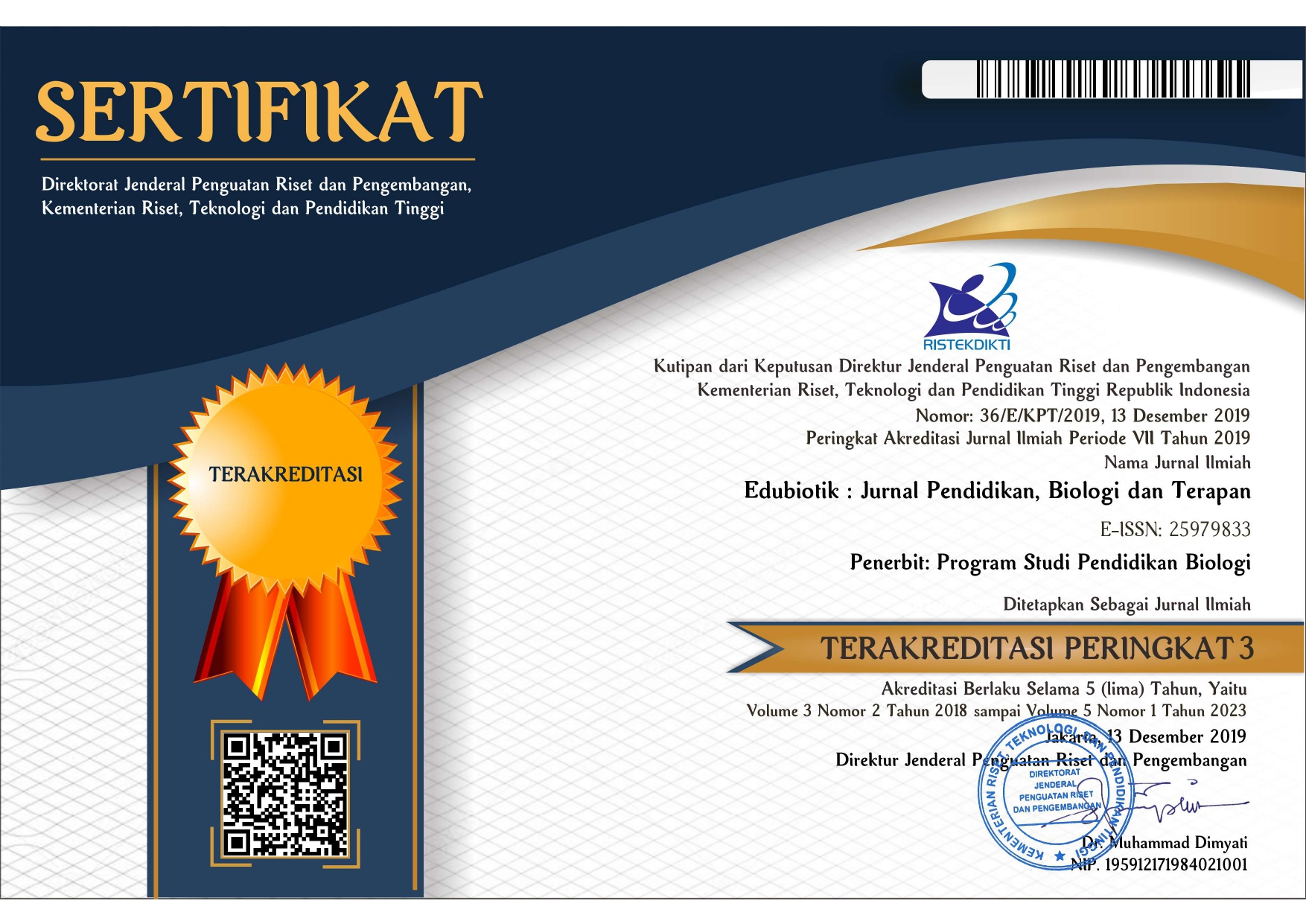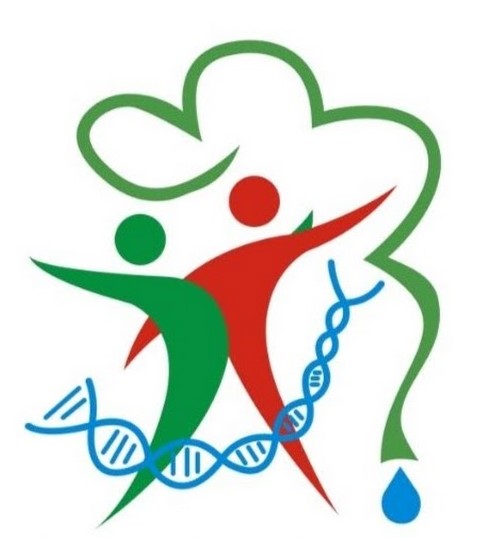Waters quality test based on macrozoobenthos bioindicator parameter in the Bolong river, Magelang
Abstract
The exploration of macrozoobenthos diversity as a bioindicator parameter in the Bolong river, Magelang has not been widely carried out. This study aims to determine the water quality of the Bolong river based on macrozoobenthos Bioindicator parameters. This research method uses a qualitative descriptive approach. The water quality test is measured based on the level of macrozoobenthos diversity according to the Shannon-Wienner diversity index. The purposive sampling method is used to determine 5 stations for sample collection. The intake of macrozoobenthos is done by using a Surber net and a tray at the bottom of river waters. Moreover, sampling is carried out with three repetitions. The data is analyzed using a diversity index, uniformity index, and dominance index to determine the water quality based on the Bioindicator parameters. Based on the result of the study, the macrozoobenthos diversity index is 1.028. Based on this index, the quality of waters in the Bolong river is considered as moderate pollution.
References
Akindele, E. O., Ehlers, S. M., & Koop, J. H. E. (2019). First Empirical Study of Freshwater Microplastics in West Africa Using Gastropods from Nigeria as Bioindicators. Limnologica, 78, 125708. Retrieved fromhttps://agris.fao.org/agris-search/search.do?recordID=US201900446650
Allesina, S., & Levine, J. M. (2011). A Competitive Network Theory of Species Diversity. Proceedings of the National Academy of Sciences, 108(14), 5638–5642. Retrieved from https://www.pnas.org/content/108/14/5638
De Jong, M. F., Baptist, M. J., Lindeboom, H. J., & Hoekstra, P. (2015). Relationships Between Macrozoobenthos and Habitat Characteristics in An Intensively Used Area of the Dutch Coastal Zone. ICES Journal of Marine Science, 72(8), 2409–2422. Retrieved from https://research.wur.nl/en/publications/relationships-between-macrozoobenthos-and-habitat-characteristics
Fadhilah, N., Masrianih, H., & Sutrisnawati, H. (2013). Keanekaragaman Gastropoda Air Tawar di Berbagai Macam Habitat di Kecamatan Tanambulava Kabupaten Sigi. E-Jipbiol, 2, 13–19. Retrieved from http://jurnal.untad.ac.id/jurnal/index.php/EBiol/article/view/2690
Fastawa, F., Agustina, E., & Kamal, S. (2019). Keanekaragaman Makrozoobenthos sebagai Bioindikator Pencemaran di Kawasan Payau Krueng Aceh. Prosiding Biotik, 5(1). Retrieved from https://jurnal.ar-raniry.ac.id/index.php/PBiotik/article/view/4275
Fisesa, E. D., Setyobudiandi, I., & Krisanti, M. (2014). Kondisi Perairan dan Struktur Komunitas Makrozoobentos di Sungai Belumai Kabupaten Deli Serdang Provinsi Sumatera Utara. Jurnal Depik, 3(1), 1–9. https://doi.org/https://doi.org/10.13170/depik.3.1.1087
Ilarri, M. I., Freitas, F., Costa-Dias, S., Antunes, C., Guilhermino, L., & Sousa, R. (2012). Associated Macrozoobenthos with The Invasive Asian Clam Corbicula Fluminea. Journal of Sea Research, 72, 113–120. Retrieved from https://www.cabdirect.org/cabdirect/abstract/20123393967
Indra, I., & Sahidin, A. (2019). Macrozoobenthos Community Structure in Cijulang River Pangandaran District, West Java Province, Indonesia. World Scientific News, 128(2), 182–196. Retrieved from http://psjd.icm.edu.pl/psjd/element/bwmeta1.element.psjd-a7b888d7-22d5-4569-8e6b-3572e5b5480a
Khedhri, I., Afli, A., & Aleya, L. (2017). Structuring Factors of The Spatio-Temporal Variability of Macrozoobenthos Assemblages in A Southern Mediterranean Lagoon: How Useful for Bioindication is A Multi-Biotic Indices Approach? Marine Pollution Bulletin, 114(1), 515–527.
https://doi.org/10.1016/j.marpolbul.2016.10.023
Mulia, S. N. (2016). Keanekaragaman Spesies Makrozoobentos sebagai Indikator Kualitas Air Sungai Kreo Sehubungan dengan Keberadaan TPA Jatibarang. Life Science, 4(2), 73–78. Retrieved from https://journal.unnes.ac.id/sju/index.php/UnnesJLifeSci/issue/view/937
Prajoko, S. & Ismawati, R. (2018). Water Feasibility Study of Bengawan Solo River for Irrigation: The Need for Technology to Solve Rice Field Pollution in Sragen, Indonesia. International Journal of Applied Biology, 2(1), 12–21. https://doi.org/10.20956/ijab.v2i1.3971
Purwati, S. U. (2015). Karakteristik Bioindikator Cisadane: Kajian Pemanfaatan Makrobentik untuk Menilai Kualitas Sungai Cisadane. Jurnal Ecolab, 9(2), 47–59. https://doi.org/10.20886/jklh.2015.9.2.47-59
Rafi’i, M., & Maulana, F. (2018). Jenis, Keanekaragaman dan Kemelimpahan Makrozoobentos di Sungai Wangi Desa Banua Rantau Kecamatan Banua Lawas. Jurnal Pendidikan Hayati, 4(2). https://doi.org/http://doi.org/10.33654/jph.v4i2.443
Riniatsih, I., Hartati, R., Redjeki, S., & Endrawati, H. (2018). Studi Keanekaragaman Makrozoobentos pada Habitat Lamun Hasil Transplantasi dengan Metode Ramah Lingkungan. Jurnal Kelautan Tropis, 21(1), 29–36. Retrieved from https://ejournal2.undip.ac.id/index.php/jkt/article/view/2401
Setiawan, D. (2009). Studi Komunitas Makrozoobenthos di Perairan Hilir Sungai Lematang Sekitar Daerah Pasar Bawah Kabupaten Lahat. Jurnal Penelitian Sains, 9(D), 12–14. Retrieved from https://jpsmipaunsri.files.wordpress.com/2010/08/1467-72-d-doni-ganjil.pdf
Sinaga, N. N., Herawati, H., Hamdani, H., & Sahidin, A. (2019). Structure of Macrozoobenthos (Gastropods) Community in Mangrove Forest Ecotourism Pandansari Kabupaten Brebes, Central Java. Asian Journal of Fisheries and Aquatic Research, 1–6. Retrieved from https://www.journalajfar.com/index.php/AJFAR/article/view/30057
Tarwotjo, U., Rahadian, R., & Hadi, M. (2018). Community Structure of Macrozoobenthos as Bioindicator of Pepe River Quality, Mojosongo Boyolali. Journal of Physics: Conference Series, 1025(1), 12039. https://doi:10.1088/1742-6596/1025/1/012039
Triwiyanto, M. S. (2015). Keanekaragaman Moluska di Pantai Serangan, Desa Serangan, Kecamatan Denpasar Selatan, Bali. Jurnal Biologi, 19(2), 63–68. https://doi.org/10.24843/JBIOUNUD.2015.vol19.i02.p03
Vilmin, L., Flipo, N., Escoffier, N., & Groleau, A. (2018). Estimation of The Water Quality of A Large Urbanized River as Defined by The European WFD: What is The Optimal Sampling Frequency? Environmental Science and Pollution Research, 25(24), 23485–23501. Retrieved from https://link.springer.com/article/10.1007/s11356-016-7109-z
Wiadnyana, N. N., & Husnah, H. (2017). Upaya Pengelolaan Perairan Sungai Musi, Sumatera untuk Keberlanjutan Pemanfaatan Sumber Daya Ikan. Jurnal Kebijakan Perikanan Indonesia, 3(1), 13. https://doi.org/10.15578/jkpi.3.1.2011.13-26
Yanygina, L. V. (2012). The Role of Viviparus Viviparus (L.) (Gastropoda, Viviparidae) in Formation of Macrozoobenthos Communities in The Novosibirsk Reservoir. Russian Journal of Biological Invasions, 3(1), 64–70. https://doi.org/10.1134/S2075111712010146





.png)
2.png)

1.jpg)


